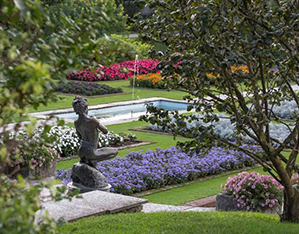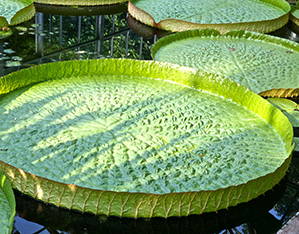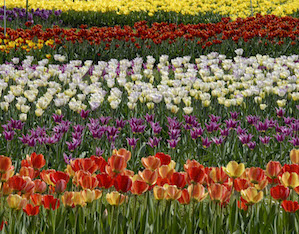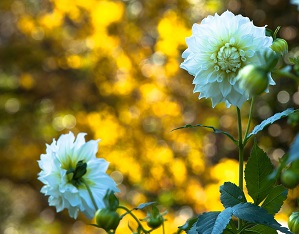Boundless botanical curiosity originating in the British Isles, augmented by the special microclimate of the lake: this famous garden of somewhat Victorian tastes has joyous flowerbeds, exotic greenhouses, and rare specimens that are now in their maturity.
In 1931, an advertisement appeared in “The Times” regarding the sale of a villa, at that time known as “la Crocetta”. It was read by a Scottish Captain called Neil McEacharn, who was travelling on the Orient Express. Thus begins the story of one of the most important botanical gardens in the world. Designed by Swiss architect Augusto Guidicini for Count Orsetti, the villa occupies a panoramic position, in a park overlooking Lake Maggiore that, between 1931 and 1940, would be transformed into a botanical garden that took advantage of the favorable micro-climate. The complex was renamed to honour an ancestor of the buyer’s, who Napoleon had appointed Duke of Taranto. Gardener Henry Cocker directed the works, blending together areas of different character, ranging from formal Italian (with pools, statues and terraces), to “English”, criss-crossed by some 7 km of paths that constantly offer different botanical scenes and landscapes. Over the years, the garden has grown richer and richer: the 8,500 species catalogued by McEacharn in 1963 have now risen to almost 20,000, and include: eucalyptus, azaleas, rhododendrons, magnolias, maples, camellias, dahlias, tulips, lotus flowers, heather, hydrangeas, and rare tropical plants. Neil McEacharn donated the villa to the Italian State in 1939, retaining the right to use it and be buried there, in a mausoleum built in 1965. The areas of the park flow into one another with great variety. Thanks in part to the seasonal blooms, it is a more-or-less continuous spectacle: from the entrance boulevard with its dense conifers to the labyrinth of dahlias, a little valley full of arboreal broom and the Cotoneaster waterfalls, terraced gardens with pools, statues and beds of annual plants, which are perhaps the park’s hallmark feature.
Highlights

Large terraced garden
Originally conceived as a rose garden, the large terraced garden features basins, small waterfalls and fountains, as well as a bronze statue of a Fisherman(1876) by Vincenzo Gemito. Colourful beds of annual species complete the composition.

Greenhouse of Tropical Plants
Among others, the greenhouse hosts Victoria cruziana, originally from Paraguay, an enormous equatorial water lily whose seeds arrived here in 1956 from the Botanical Garden of Stockholm.

Blooms
80,000 bulbous plants (65 different varieties) bloom in April; in May, it’s the turn of azaleas and rhododendrons; in late summer, 1,700 dahlias (350 varieties).

Collection of Dahlias
In a blaze of colours, shapes and sizes, from the last ten days of July until the end of October, visitors can admire the exuberant flowering of more than 1,700 dahlia plants from over 350 varieties, including the Decoratives with their large flowers, and the Pompons, with their typical honeycomb inflorescences.
 Villa Taranto
Contacts
Villa Taranto
Contacts
Contacts
Telephone:+39 0323 556667
+39 0323 404555 (biglietteria)
Address
Via Vittorio Veneto, 111
28922 , Pallanza (VB)
 Villa Taranto
Opening times and prices
Villa Taranto
Opening times and prices
Opening hours
From March to November 2021 Villa Taranto will be open every day, including holidays, all day long:
- March: 9 am – 5.30 pm last admission – 6.30 pm park closure
- April-September: 9.00 am – 6.30 pm last admission – 7.30 pm park closure
- 1 October-17 October: 9 am – 5.30 pm last admission – 6.30 pm park closure
- October 18-November 7: 9 am – 4 pm last admission – 5 pm park closure
Pricing
- Single adults: € 11,00
- Single kids (from 6 to 14 years): € 5,50
- Groups from 21 to 100 people: € 8,00 (per person)
- Groups over 100 people: € 6,00 (per person)
- Groups of schools and colleges: € 4,50 (per person)
- Annual subscription: € 70,00
- Summer subscription (3 months): € 35,00
- Free admission: children from 0 to 5 years old; group leader; one teacher for every 20 students; 100% disabled person and accompanying person.
 Villa Taranto
How to get there
Villa Taranto
How to get there
Address
Via Vittorio Veneto, 111
28922 , Pallanza (VB)
Latitude: 45.925914
Longitude: 8.565281
How to arrive by road
From the centre north: motorway A26 VOLTRI-GRAVELLONA TOCE, exit BAVENO/STRESA – 11 km along the SS33 towards VERBANIA. From the north of the Alps 3 main passes: Simplon, S. Gotthard, S. Bernardino – the gardens are more or less 100 km from each of the above mentioned passes; Simplon – A26/E62 AUTOSTRADA DEI TRAFORI motorway, exit VERBANIA – along the SS34 towards VERBANIA PALLANZA; S. Gotthard and S. Bernardino: drive along the west bank on the SS33 – about 28 km from the Swiss-Italian customs you arrive in Pallanza – follow road signs for Villa Taranto.
How to arrive by train
Milano – Domodossola line. Verbania station is located in the hamlet of Fondotoce and is 9 km from the Gardens. Bus services connect Verbania with the city.
 Villa Taranto
Services/Accessibility
Villa Taranto
Services/Accessibility
Services
Dogs are allowed only if on a leash and only along the pedestrian walkways.
There is a bar/restaurant and a cafeteria in the gardens.
There is a bar/restaurant and a cafeteria in the gardens.
There is a bar/restaurant and a cafeteria in the gardens.
There is a bar/restaurant and a cafeteria in the gardens.
Inside the garden there is a bookshop with a vast assortment.
Accessibility
The garden can be visited in a wheelchair following a marked path.
 Villa Taranto
Private events
Villa Taranto
Private events
 Villa Taranto
Itineraries
Villa Taranto
Itineraries
You could find the garden in these itineraries
 Favorite saving result
Favorite saving result
 Warning!
Warning!
You've have to sign up or sign in to add this element to your favorites.
